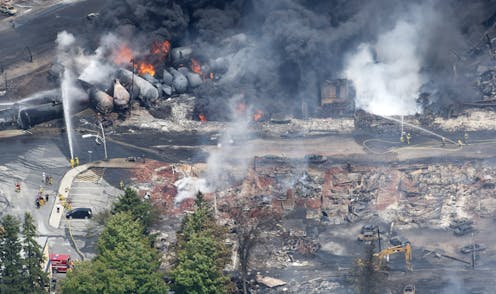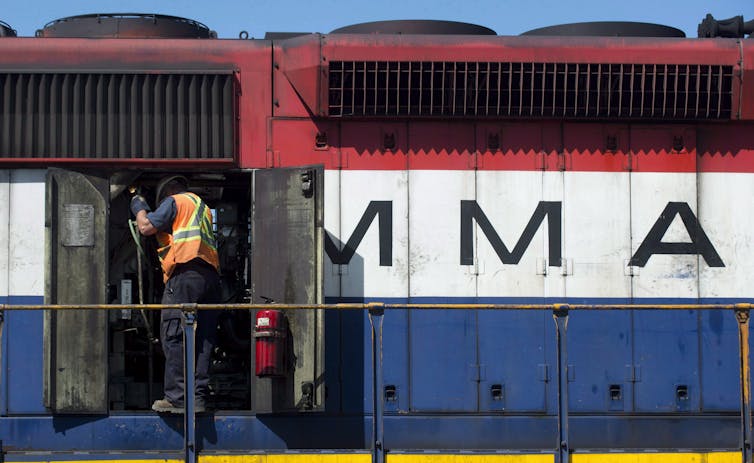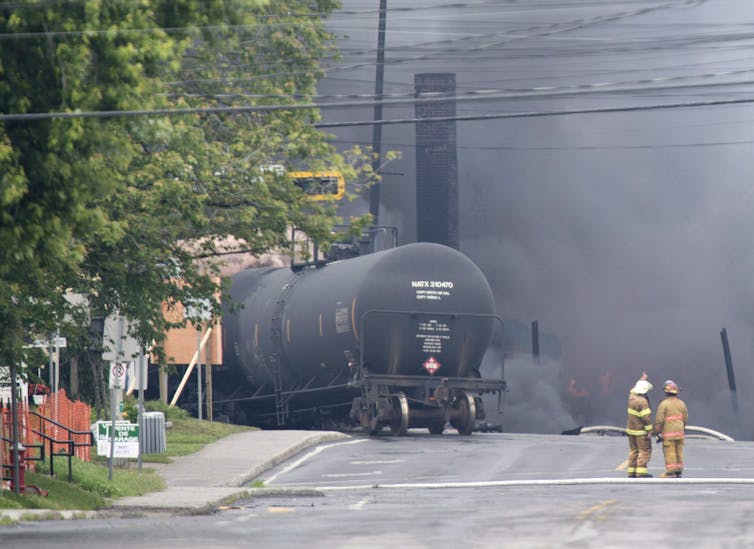
On July 6, 2013, a runaway train carrying 72 tank cars loaded with volatile Bakken shale oil derailed and exploded in Lac-Mégantic, a small town in southeastern Québec. It killed 47 people, orphaned 26 children, spilled a record six million litres of oil and incinerated the town centre.
It was the worst rail disaster in more than a century — a catastrophe described by the editor of the local weekly newspaper as “a chain of explosions and the sound of whistling gas escaping from everywhere: the vomiting bowels of hell.”
In my book The Lac-Mégantic Rail Disaster: Public Betrayal, Justice Denied, I detail how the tragedy was the consequence of four decades of mutually reinforcing policies — deregulation, privatization, tax cuts and austerity — that eroded transportation safety protections. They entrenched the power of railway corporations in concert with government enablers and regulators — a phenomenon known as “regulatory capture.”
Austerity produced a vicious cycle where gutted regulatory resources increased pressure to devolve responsibility to private companies. Euphemistically called co-regulation or partnership, it was, in effect, self-regulation.
Read more: Why major Canadian railways must no longer be permitted to police themselves
Oil by rail
In the years leading up to the disaster, the volume of oil transported by rail in Canada soared from 500 tank cars in 2009 to 160,000 in 2013. Resources within regulatory agencies were woefully inadequate to deal with the mounting danger.
In 2009, there was the equivalent of 14 tank carloads of crude oil per inspector working under the federal government’s Transportation of Dangerous Goods Program. By 2013, that ratio had increased to about 4,500 carloads per inspector.
The railway lobby, along with its petroleum allies, successfully argued that additional safety regulations to address the danger were not necessary. They also secured a change in the rules to allow trains carrying dangerous goods to operate with a single crew member despite much opposition, including from within Transport Canada.
Huge volumes of volatile oil were being hauled through Lac-Mégantic by Montreal Maine & Atlantic, known as MMA — a company with a downsized workforce, shoddy locomotives, a poor safety record and operating on a poorly maintained track.

The first to move cargo under the single-operator rule, MMA’s DOT-111 tank cars were originally designed for carrying corn oil. Safety boards in both Canada and the United States had warned against railways carrying dangerous goods in these tank cars for years.
It was a perfect storm of regulatory failure and corporate negligence; an accident waiting to happen.
Who’s been held accountable?
Three front-line workers were criminally charged and acquitted in the Lac-Mégantic disaster.
No senior official, politician, corporate executive, director or owner has been held to account for their role and responsibility for the tragedy. Successive governments have refused demands by the community to establish an independent commission of inquiry.
Civil suits, including a class-action lawsuit filed on behalf of town residents, resulted in a 2015 plea deal with 24 defendants, including the federal government, contributing to a $460 million settlement fund protecting them from further charges.
A lone defendant, Canadian Pacific Railway — the company contracted to transport the cargo from North Dakota to the Irving refinery in Saint John, N.B. — refused to settle.
After repeated delays, Québec Superior Court ruled in December 2022 that CP could not be held liable for damages suffered by the Lac-Mégantic victims — another setback in the fight for justice. The plaintiffs have appealed the court ruling.

Disaster aftershocks
The Lac-Mégantic community has been plagued by a legacy of economic, health and environmental aftershocks following the disaster.
Trains carrying dangerous goods continue to rumble through the town, whistles shrieking day and night. These longer, heavier trains still descend the steep slope and around the sharp curve where the fateful train derailed. They still carry dangerous goods in the original, or slightly upgraded, DOT-111 tank cars — the same kind that derailed and spilled that tragic night.
Trains with multiple tank cars containing only oil no longer run through the town, at least for now. The fear of another derailment continues to keep residents on edge.
Construction of a long-promised bypass around the town still hasn’t begun. The bypass was supposed to be a step toward healing Lac-Mégantic, but the chosen route has sharply divided the community.
Opposition to this route — preferred by Canadian Pacific, which will own the government-financed bypass upon completion — means further delay. Those whose lands will be appropriated are seen as the latest victims of the disaster. Completion of the bypass is years away.
In the meantime, another Lac-Mégantic-type disaster is still possible. Regulatory agency resources are still woefully inadequate to undertake effective safety oversight and enforcement.

Ongoing safety issues
Transport Canada’s safety management systems have continuously been on the Transportation Safety Board’s (TSB) watchlist created to highlight “those issues posing the greatest risk to Canada’s transportation system.”
In its most recent 2022 watchlist, the board noted that safety management systems are “still not effectively identifying hazards and mitigating risks in rail transportation.”
What’s more, the federal government is failing to lift the veil on corporate activities protected by commercial confidentiality. When compared to legislation internationally, Canada’s access-to-information laws and whistleblower protections rank poorly.
The TSB’s 2022 watchlist concluded that unplanned or uncontrolled movement of rail equipment, which include runaway trains, continue to “create high-risk situations that may have catastrophic consequences.”
Yet Transport Canada still hasn’t mandated modern braking systems on trains, a move that could have prevented Lac-Mégantic and other runaway trains. Railways are unwilling to incur the extra costs involved.
Companies continue to resist installing effective work-rest practices for workers in accordance with sound science and the government’s promise to implement regulations have still not occurred. Fatigue remains on the TSB watchlist as posing a safety risk to operations.

‘Window still open’
A 2020 report on the transportation of dangerous goods by the Environmental Commissioner in the Auditor General’s Office warned:
“The window for a recurrence of a Lac-Mégantic-type disaster is still open.”
Lac-Mégantic haunts rail transportation in North America.
If we are to minimize the risk of future disasters, stronger regulations must be put in place.
While odds of transcending the power status quo are formidable, to paraphrase Italian philosopher Antonio Gramsci, giving up the fight is not an option.
Bruce Campbell is affiliated with several non-governmental organizations: the Canadian Centre for Policy Alternatives, the Rideau Institute for International Affairs, the Group of 78
This article was originally published on The Conversation. Read the original article.







